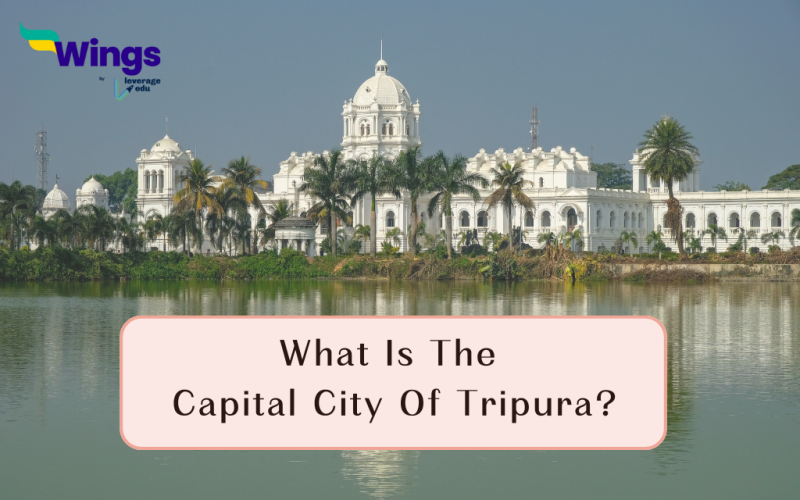Agartala, the capital of Tripura, is situated in northeast India. The city has a rich history and cultural heritage and is located among lush greenery. Agartala serves as Tripura’s political and commercial centre, offering a unique blend of tradition and modernity. From the beautiful Ujjayanta Palace, a captivating museum, to the markets filled with local crafts, Agartala is a captivating, serene beauty. Read this blog to learn more about ‘What is the Capital City of Tripura’.

Overview of Agartala
Table of Contents [show]
The capital city of Tripura, Agartala, is considered the largest city in Tripura. Let us get an overview of “What is the capital city of Tripura?”
- The capital city of Tripura, Agartala, is the gateway for the other states of Northeast India.
- Agartala, the capital of Tripura, has a rich history and has been ruled by several kingdoms.
- However, it was an independent state before it merged with India in 1949.
- The capital city of Agartala is considered to be a hub of the culture of Tripura, with a blend of Bengal, Tripuri and its ancient tribals.
- Agartala has beautiful lakes like Tripura Sundari Temple, a Hindu temple complex located on an island amidst a lake.
- Agartala has a number of festivals that are celebrated across the city, like Durga Puja.
Also read: What is the Capital City of Gujarat?
History Of The Capital City Of Tripura.
The capital city of Tripura has a vibrant and rich history:
- The history of Agartala can be linked back to the mythological Tripura kingdom, which is mentioned in the ancient epics.
- It was during the 15th century that the capital of Agartala became the capital of Tripura kingdom, as it was located very strategically.
- The Tripura kingdom faced challenges from the Mughals, with Agartala under their control in the 16th and 17th centuries.
- During the 18th and 19th centuries, the Tripura kingdom experienced an expansion, and Agartala grew with a lot of development in the city.
- It was the arrival of the British East India Company that influenced the growth of Agartala and its political landscape.
- The 20th century saw Tripura, including Agartala, experience political unrest and social changes leading to India’s independence.
- In 1949, Tripura, including Agartala, merged with the newly independent India, becoming a part of Tripura territory.
- Post-independence, Agartala has witnessed significant development, becoming a commercial and cultural hub for Tripura.
Geography Of Agartala
Agartala, the capital of Tripura, sits on a fertile plain along the Haora River. However, the city also extends to the low-lying hills on its northern fringes.
- The Haora River plays a pivotal role in Agartala’s geography as it provides water for irrigation, and transportation and is also one of the most beautiful features of the city.
- Agartala has a strategic location in western Tripura, bordering Bangladesh and serves as a gateway to other northeastern states of India.
- The city falls within the coordinates of 23° 45′ – 23° 55′ N latitude and 91° 15′ – 91° 20′ E longitude.
- Agartala has a low elevation, with its highest point being around 12.8 meters above sea level.
- As Agartala expands, its geographical layout is constantly evolving with new roads, buildings, and improved infrastructure.
Also read: What Is The Capital City Of Tamil Nadu?
What Is the Demography of Agartala?
The capital city of Tripura has a rich and vibrant demographic culture;
- Bengali is one of the most dominant languages and ethnic groups in the capital of Tripura.
- The indigenous Tripuri people also have a notable presence in the city, contributing to its cultural richness.
- Manipuri, Reang and Hindi are among the smaller communities that contribute to Agartala’s diverse population.
- Hinduism is the predominant religion in Agartala, followed by Islam, Christianity, and Buddhism.
- Tripura boasts the highest literacy rate in India, and Agartala reflects this with a well-educated population.
- The sex ratio in Agartala is relatively balanced, with a slight female majority.
- Agartala has a relatively young population, with a significant portion falling under the 30-year-old age bracket.
- Bengali, Kokborok (Tripuri language), and English are the official languages used in Agartala.
FAQs
The capital city of Tripura is Agartala, situated in northeast India. It serves as the political and commercial center of the state, blending tradition and modernity amidst lush greenery.
Agartala has a rich history dating back to the mythological Tripura kingdom. It became the capital in the 15th century and faced challenges from various rulers including the Mughals. Post-independence, it merged with India in 1949 and witnessed significant development.
Agartala has a diverse demographic culture, with Bengali being dominant. The indigenous Tripuri people also contribute significantly. Other communities like Manipuri, Reang, and Hindi-speaking groups add to its richness. Hinduism is the predominant religion, and the city boasts the highest literacy rate in India.
Related Blogs
That is all about what is the capital city of Tripura! If you want to know more about topics like this, then visit our general knowledge page!
 One app for all your study abroad needs
One app for all your study abroad needs















 45,000+ students trusted us with their dreams. Take the first step today!
45,000+ students trusted us with their dreams. Take the first step today!
